East Sussex wartime writers and artists (3)
Posted: 19 August 2013 19:54
As today sees the 71st anniversary of the Dieppe Raid, I thought it appropriate to look at some photos of Canadian tanks with a Sussex connection.
The raid, as is widely known, was a disaster, despite the heroic action of Canadian and Allied forces. 907 Canadians lost their lives, most of whom were stationed in East Sussex just a few months prior to the operation.
Allied propaganda
Our first angle is the official photograph shown below, which was seemingly released as a morale-boosting postcard by the UK authorities as part of a "For Freedom" information campaign.
The caption extols the virtues of the new Churchill Tank. The Churchill was an 'Infantry' ('I') tank, intended to support advancing infantry and so was heavily armoured and slower than the American Grant, Lee and Canadian Ram tanks being driven around the training areas of Sussex. The 'I' tank was intended to keep infantry assaults moving, so the idea of deploying a Churchill as a static pillbox is somewhat contrary to tactical doctrine!
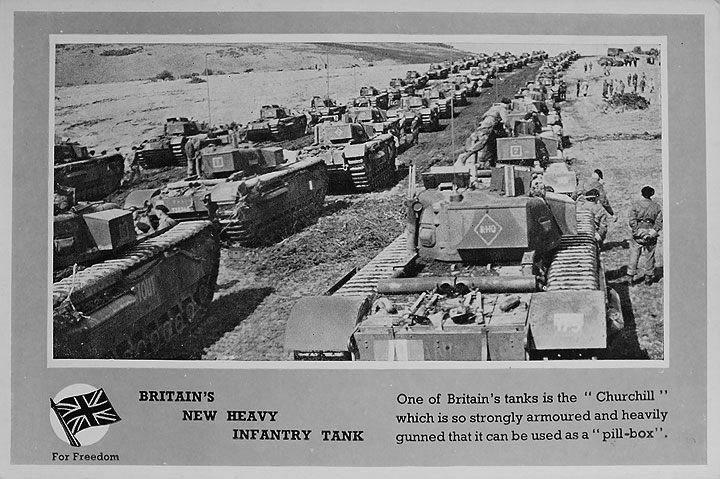
The tanks were on parade on the Sussex Downs and being inspected by Prime Minister Churchill himself. The scene as it is today is shown below; the wheel ruts probably equate to the centre column of tanks in the wartime photo.
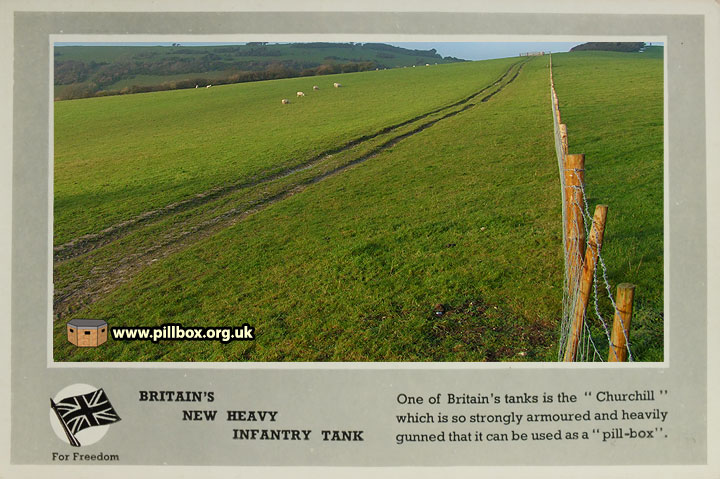
For all the fanfare surrounding the new tank, its first use in action proved to be a disaster - the Dieppe Raid of 19th August 1942.
To be fair, it was not the fault of the Churchill tank - it was the circumstances into which it was thrown into battle. Deep water and deep shingle were not ideal for the tanks (despite wading gear being fitted) and of the 29 that landed on the French coast, only 15 made it to the seawall. None of these tanks that landed were evacuated during the withdrawal.
The remainder of the Calgary Regiment that returned to England was briefly relocated to Somerset and so probably did not experience first-hand a German attempt to publish material in wartime Sussex.
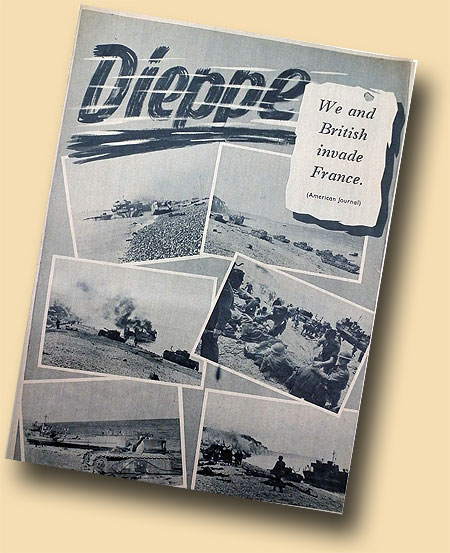
German propaganda
At some point between the 6th and 7th September, the Germans warranted their inclusion in this series of artists and writers by dropping propaganda leaflets on the south coast of England, from where the raid had been launched.
The front cover is shown at right.
The pamphlet was quite elaborate, and according to propaganda expert @psywarorg (http://www.psywar.org), this was one of the better German leaflets, comprising four pages in which the photographs spoke for themselves.
This perhaps indicates that the Germans didn't have to work too hard, as the scale of the Allied disaster is all too clear from the photos the propagandists selected.
The photos bluntly depict bodies strewn on the beaches along with knocked-out tanks. Prisoners and wounded also feature prominently.
A few photos from the inner spread are shown below.
It is poignant to think that the tanks you see wrecked in the photos below will be somewhere in the postcard photo above, taken just a few weeks earlier on the Sussex Downs.
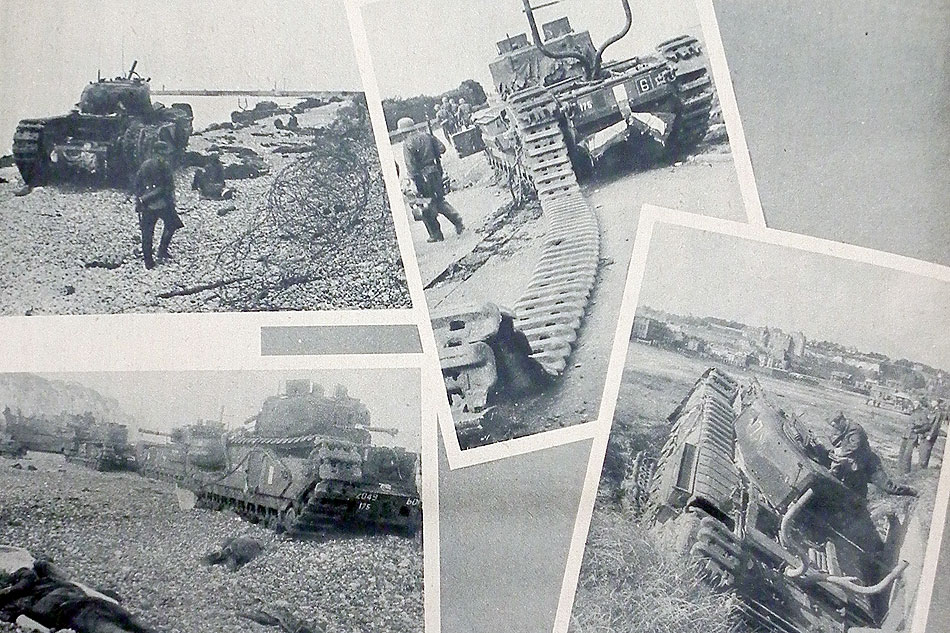
How was this leaflet received in East Sussex? We have two references to it from Canadian units who arrived in the area shortly before Operation Jubilee. The first is from the war diary of a unit in Eastbourne:
German propagandists have drawn up a pictorial leaflet of the aftermath of Dieppe and intended to distribute them in this area. However, the container, after being dropped from a plane, did not explode, and fell to the earth intact. Several of these leaflets have been received by the unit and depict derelict equipment, prisoners, etc, captured by the Hun. All in all it is a remarkable piece of propaganda. (Emphasis added)
The author here seems to be in admiration of the Germans' efforts, though not seemingly concerned about any negative effect it might have on Canadian morale. The leaflet is seen as propaganda (and it would be impossible to recognise it as anything but, given the clear origin and method of delivery), but the failure of the leaflet canister to open restricted distribution anyway.
A sister tank battalion to the Calgary Regiment in Brighton, took a very different view of the effectiveness of the leaflet:
German aircraft overhead about noon distributing pamphlets which will be baled and used to further the war effort. These pamphlets, alleged to be propaganda, have been of value to the Intelligence Branch as they clearly showed some facts which had been in doubt.They showed the beach with some Canadian Tanks but avoided the town and what the rest of the tanks did to it.
Prisoners of war pictures showed a marked contrast to pictures of the dejected German & Italian P.W.'s from Middle East. Our men were standing up nonchalantly or playing cards - certainly not worried or humble.
In sharp contrast, the author of this diary entry turns the tables on the propaganda by identifying ways in which it actually helps the Canadians; these counter-propaganda ideas were probably distributed throughout the regiment.
The point about "facts" is very valid; in the aftermath of the raid, the Calgary Regiment was struggling to establish how many men had been lost on the raid. On 24th September, the regiment, back in Sussex again, received the first unofficial list of 19 of its men known to be in captivity. Five days later, the list totalled 59 names, but 112 men were still unaccounted for. You can see how German photos might be closely scanned for any indication of the fate of missing comrades, or to corroborate details from after-action reports.
The comparison with images of Axis prisoners is also interesting, although there is no guarantee that the Allied pictures the author refers to were not staged propaganda themselves.
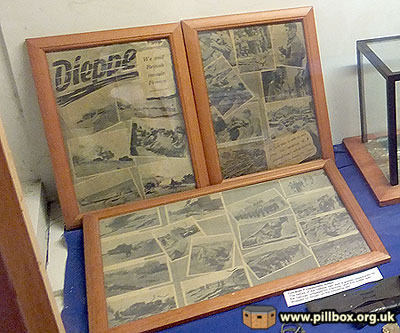
Whether or not many civilians acquired the leaflet is not recorded, but at least two copies appear in the Dieppe exhibition at Newhaven Fort (photo at right); I can't remember from the exhibit label whether these were picked up in the streets or not.
One might assume that the effect of graphic photos on civilians might have been greater, but, as we've seen with the Canadian reactions above, different people perceive things differently.
Full circle
We started out by looking at a British postcard of Canadian tanks on the Sussex Downs in 1942.
The date that the postcard was published is not known, but we know the photo predates Operation Jubilee by four months.
The Germans were probably unaware of its existence and there's no suggestion that the Dieppe leaflet was intended as a direct response to it, but it's interesting how both sides used photographs of the same tanks for the purpose of affecting morale!
- Pete

Email:
Blog Latest

Bishopstone reveals its pillbox secrets
18 October 2021

Pillbox or Observation Post?
10 June 2020

Uncovering the hidden secrets of a pillbox
8 June 2019

Review of 2018
31 December 2018

Wartime Christmas in East Sussex (2)
24 December 2018
Jargon-buster
Pillbox
Generic term for a hardened field defensive structure usually constructed from concrete and/or masonry. Pillboxes were built in numerous types and variants depending on location and role.
War diary
A record of events kept by all units from the point of mobilisation. A diary's contents vary enormously from unit to unit; some give detailed entries by the hour on a daily basis while others merely summarise events on a weekly/monthly basis.
This site is copyright © Peter Hibbs 2006 - 2024. All rights reserved.
Hibbs, Peter East Sussex wartime writers and artists (3) (2024) Available at: http://www.pillbox.org.uk/blog/216732/ Accessed: 18 April 2024
The information on this website is intended solely to describe the ongoing research activity of The Defence of East Sussex Project; it is not comprehensive or properly presented. It is therefore NOT suitable as a basis for producing derivative works or surveys!